And the Streak Goes On
I am in Fort Myers Beach, FL with co-leader Denise Ippolito along with six Happy Campers. It is 5:23am as I put the finishing touches on today’s post. I continue to feel a bit better each day and finally my blood sugar levels are normalizing; this is a sure sign that I am beating this thing. Note: Many folks are taking advantage of the Late Registration Discounts to sign up for a segment here or a weekend or a morning there. See more by scrolling down here.
This post marks 60 days in a row with a new educational blog post, a record by far that should be extended for at least another week or two. Or not. 🙂 To show your appreciation, we ask that use our B&H and Amazon affiliate links for all of your B&H and Amazon purchases. Please check the availability of all photographic accessories in the BIRDS AS ART Online Store. We sell only what I use and depend on. We will not sell you junk. We know what you need to make creating great images easy and fun. And we are always glad to answer your gear questions via e-mail.
You can find the following items in the store: Gitzo tripods, Mongoose M3.6 and Wimberley heads, plates, low feet, and accessories, flash brackets, , Delkin e-film Pro Compact Flash Cards, LensCoat products, and our unique line-up of educational materials including ABP I & II, Digital Basics, Site and Set-up e-Guides, Canon and Nikon Camera Users and AF e-Guides, and MP-4 Photoshop video tutorials among others.
We would of course appreciate you using our B&H and Amazon affiliate links for all of your B&H and Amazon major gear, video, electronic, household, and personal purchases. For the photographic stuff mentioned above we would of course great appreciate your business.
Thanks and enjoy today’s blog post! This one took only about 2 hours (with Dave’s help) to assemble as I did not need to process any images.
Less Than a Week Left to Enter! BIRDS AS ART 2nd International Bird Photography Competition!
With so many folks signing up at the last minute at the end of December and with so many folks having trouble uploading their images due to server overload, the deadline for entering the contest (registering and paying) was extended just before the end of the last year until January 31, 2014. There will be no additional extensions. The deadline for uploading your images has been extended until midnight Eastern time on February 10, 2014. Take advantage of this extension to have a crack at the great prizes.
Learn more and enter the BIRDS AS ART 2nd International Bird Photography Competition here. Twenty-five great prizes including the $1000 Grand Prize and intense competition. Bring your best.
Register and Pay
To register click here.
To learn of payment options, click here.
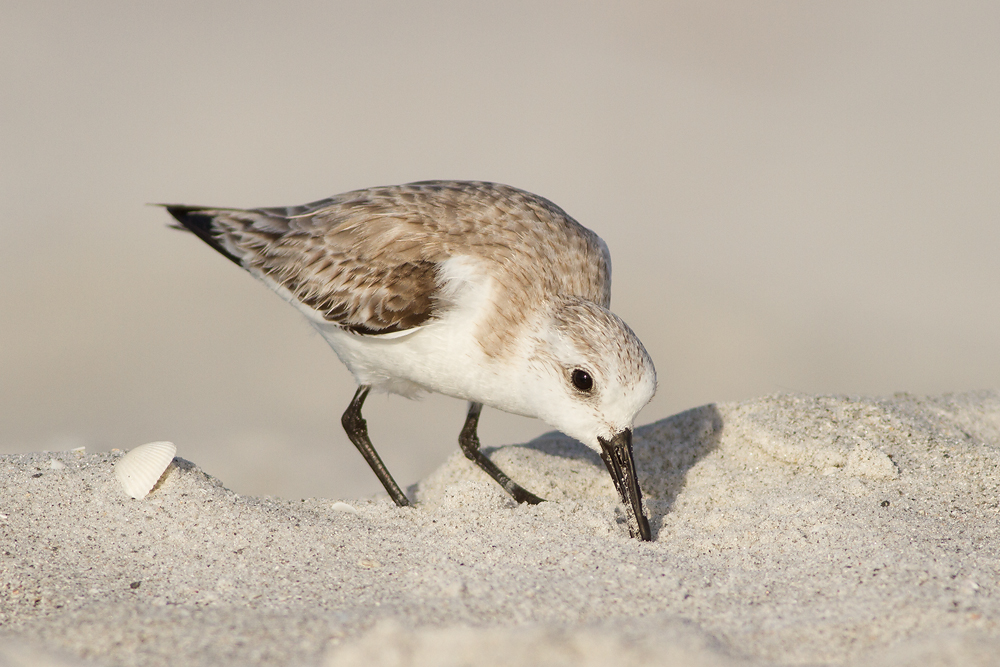
|
|
This Sanderling image was created with the hand held Canon EF 400mm f/5.6L USM lens and the Canon EOS 7D. ISO 200. Evaluative metering +1/3 stop: 1/1600 sec. at f/5.6 in Manual mode. Image courtesy of and copyright 2013 David Hardcastle. Notice that Dave has pointed his shadow at the subject….artie |
EOS-7D & 400mm f/5.6L Make Darned Good Images
I get lots of unsolicited e-mails with JPEGs attached or embedded. Others send links to their websites or Flickr collections and ask that I take a look. If I am not too busy working on a blog post I try to take a quick peek. Some of the time I am left scratching my head, and some of the time I am quite impressed. A week ago I received the e-mail below from David Hardcastle of the UK.
Hi Arthur,
I wanted to let you know how I got on with a trip to Florida where I made heavy use of your Southwest Florida Site Guide. I made this trip with my wife a year ago – no idea why I did not e-mail sooner! I’d wanted to visit Florida for many years, mainly due to seeing all your photographs. I wasn’t disappointed. There were lots of great photo opportunities and the tameness of the birds was amazing and a real change from the way they generally are in England.
We spent a couple of nights on Sanibel Island. We visited Ding Darling, which I wasn’t expecting to be great based on your guide. It was challenging for photography with few birds close to the road but we got lucky and saw a nice sunset with some silhouetted birds in front of it;that photo is attached. We returned early the following morning and again it was fairly quiet but we had one good opportunity to photograph a Great Blue Heron. For that one I the “rule of fourths” composition that you describe in ABP II.
We also visited most of your other recommended sites on Sanibel; the highlight was Bowman’s Beach on our last day. We were there at the end of the afternoon which was the wrong time of day to be honest in terms of light direction–this was not purely a photography holiday). By getting perilously close to the gulf I was able to get the light behind me. I enjoyed some great opportunities with Sanderling, turnstone, and particularly a Black-bellied Plover. In the attached image of the plover with the green background the original shot was too tight because I couldn’t get farther back or I’d have been lying in the sea! So I had to add canvas left and above using the techniques covered in APTAPS II.
All shots were taken with a 7D; I’d love a 1D X and one of the newer super-telephotos, but they’re out of my price range – the 7D/400mm f5.6 does me pretty well.)
Having never been to Florida before, the guide really helped us get to the right places quickly.
Cheers – hope you can keep up the current run of a blog post a day! Dave

|
|
This Great Blue Heron image was created with the hand held Canon EF 400mm f/5.6L USM lens and the Canon EOS 7D. ISO 500. Evaluative metering -2/3 stop: 1/2000 sec. at f/5.6 in Manual mode. Image courtesy of and copyright 2013 David Hardcastle. Note that with the dark background and the heron’s bright white chin Dave knew that he needed to underexpose to prevent blowing the WHITEs. I hope that that is beginning to sound familiar to many of you. 🙂artie |
My Reply
Hey Dave,
Good to hear from you. Glad that the guide helped. I gotta say that the image quality that you get with your 7D is superb. Simply superb. I would like your permission to adapt what you wrote in your first e-mail and use it in a guest blog post. Along with several selected images of course.
I would be fine with that alone but if you could write a short paragraph or three on how you get such superb IQ with the 7D folks would love to hear that. What is your exposure strategy? How do you convert? Do you use Noise Reduction? Nothing complicated, just the basics.
thanks a stack and later and love, artie
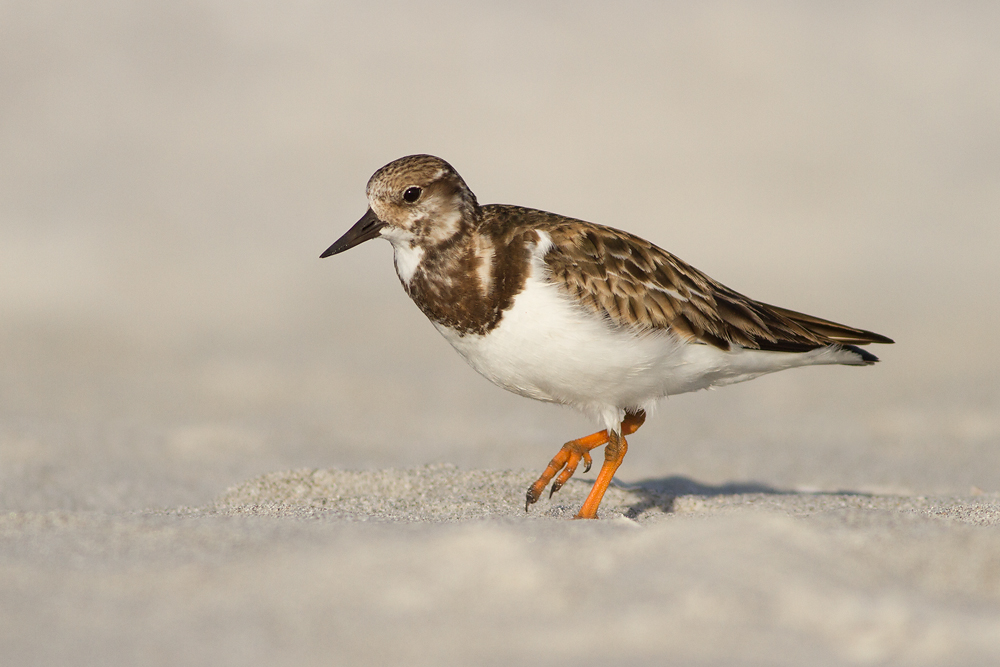
|
|
This Ruddy Turnstone image was created with the hand held Canon EF 400mm f/5.6L USM lens and the Canon EOS 7D. ISO 200. Evaluative metering +1/3 stop: 1/1600 sec. at f/5.6 in Manual mode. Image courtesy of and copyright 2013 David Hardcastle. Here I love the sharpness, the perfect exposure, and the raised foot.artie |
Dave’s Reply
Hi Arthur,
Yes, that’s fine, please go ahead and use what I sent in a blog. I can’t say I do anything particularly special with either my exposure strategy or my processing. For the exposure I obviously aim to get information in the right hand box of the histogram, but I don’t really push too hard on that – I’ve always struggled to get good looking whites when I’ve got too many blinkies (even with techniques like linear burn).
The quality of the 7D is good when the light is good. When conditions are dull then I don’t like the image quality as much; you can still get good results with care. If the photos I sent look good it’s mainly because the light was good. The photos from the beach were taken at either ISO 200 or 400. I think I started at ISO 200 but moved up to 400 to get more shutter speed. Looking at the exposure on the great blue heron, I was surprised to see that it was 1/2000 at f/5.6, ISO 500, in manual mode – my default ISO is 400 so I don’t know why I felt the need to be at 500, but there doesn’t seem to be much noise. I should say that I shoot handheld almost all the time – I’d like Canon to release an image stabilized 400mm f5.6 but I can get sharp images without a tripod, as long as I’m careful with my technique and as long as I watch my shutter speed.
For processing I use Lightroom to convert my RAW files and do anything else I need to do in Photoshop Elements. The photos I sent have had relatively little done in Lightroom – just tweaks to the white balance and maybe toning down the whites. I use the default noise reduction settings in Lightroom (0 luminance noise reduction, 25 color noise reduction); these settings are very mild but do a great job of removing any colour noise.
To create the jpgs I sent you, I just re-sized them and did three rounds of sharpening at 125 / 0.2 / 0: I m pretty sure that I learned those from ABP II.
I guess another lesson might be that it’s better to spend your money on trips to great places rather than on top-end gear; if I’d bought a 1D X I wouldn’t have been on vacation in Florida and wouldn’t have gotten those shots! Of course, ideally, you buy great gear and travel to great locations but we don’t all get to do that. Let me know if you need any more info. Thanks, and good luck with the pelicans in San Diego. Dave.
|
This Black-bellied Plover image was created with the hand held Canon EF 400mm f/5.6L USM lens and the Canon EOS 7D. ISO 400. Evaluative metering +2/3 stop: 1/2500 sec. at f/5.6 in Manual mode. Image courtesy of and copyright 2013 David Hardcastle. This image features a perfect head angle and a nice soft o-o-f background.artie |
My Reply
Hey Dave, Thanks for your help and generosity.You have a great attitude! later and love, artie
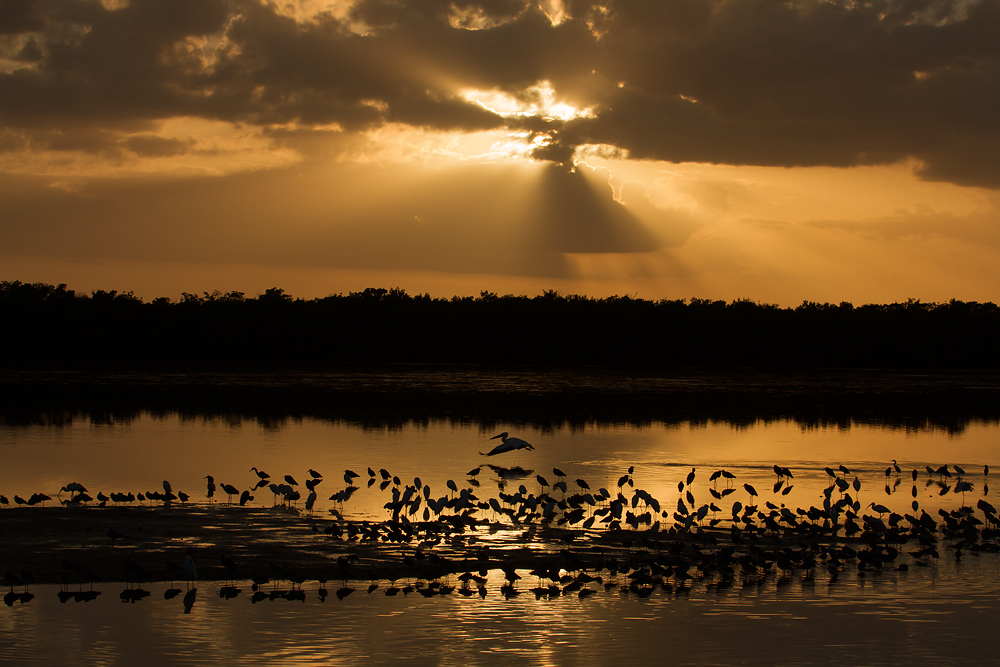
|
|
This sunset silhouette image was created at Ding Darling, NWR, Sanibel Island, FL with the hand held Canon EF 70-300mm f/4-5.6L IS USM lens and the Canon EOS 7D. ISO 200. Evaluative metering -2 stops: 1/1250 sec. at f/9 in Av mode. Image courtesy of and copyright 2013 David Hardcastle. I used the 70-300 briefly for flight in Norway: I loved it but for the fact that the zoom and focus rings were reversed from the typical Canon arrangement. It was however light, super-fast to acquire focus, and super sharp. The birds are lots of Willets, a White Ibis or two, a few assorted herons and egrets, surely some Black-bellied Plovers and Short-billed Dowitchers, and a single White Pelican.artie |
My Comments
I have stated often, “Make the best pictures that you can with the best gear that you can afford. Quit complaining about your camera and lens, study hard, and practice whenever you can…. Those who are gear hounds are asked to study the blogs, e-mail me for advice, and be sure to use one of our affiliate links when they spend their hard-earned cash.
David proves here that it is possible to create excellent images without spending $20 K (12,000+ British Pound Sterling) on a camera and a lens. He has honed his exposure and sharpness techniques, he has studied and learned from lots of our educational materials, and he has practiced his skills whenever possible.
More on the Much-maligned EOS-7D
7D interested folks would surely love to re-visit the How Dan Cadieux Masters Canon EOS-7D Image Files blog post that includes lots of great images and info.

|
|
This afternoon seminar is 100% free and open to the public. |
Free Afternoon Seminar
Join Denise Ippolito and me on the afternoon of January 28, 2014 at 1:00pm in the Boca Grande Community Center for a free two-part nature photography seminar entitled “Birds and Blooms.” At 1:00pm I will be presenting “A Bird Photographer’s Story” (updated with lots of my favorite new images). Denise will follow with her hugely popular “Bloomin’ Ideas.” The venue is located at 131 First Street West, Boca Grande, FL 33921.
Suggestion
Join us for the free seminar and then for the Venice Rookery IPT the following day. See below for details.
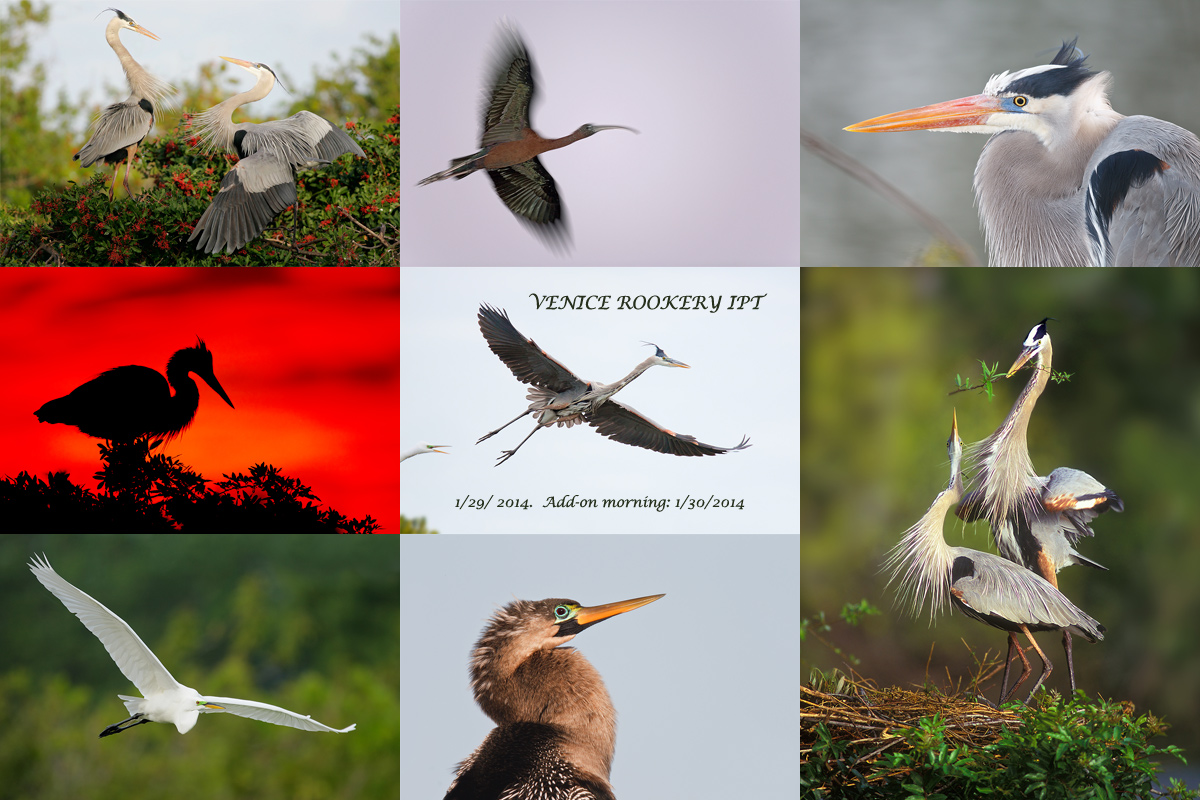
|
|
Do join us on the Venice Rookery IPT, or better yet, for the whole South Florida Composite IPT. Scroll down or click here for complete details. |
The South Florida Composite IPT
Do consider joining us for one of the remaining parts of the South Florida Composite IPT. Call me on my cell at 863-221-2372 or e-mail to learn of the Late Registration Discounts for both the segments and the complete trip. If you call the cell and I do not pick up, please let a message and please be sure to e-mail me a good callback number and time.
Jan 29 (WED): Venice Rookery In-the-Field: all day: (Limit 12/Openings 8): $399. Introductory slide program 7pm, Jan 28.
30 (THURS) -Venice am only. (Limit 12/Openings 7): $249
You can sign up for one or more of the short IPTs and/or one or more of the add-on days or you can opt to sign up for the all the sessions. Those signing up for the whole shebang will be having all lunches and dinners with us most every day. Call us at 863-692-0906 or e-mail to learn of the Late Registration Discounts for both the segments and the complete trip.
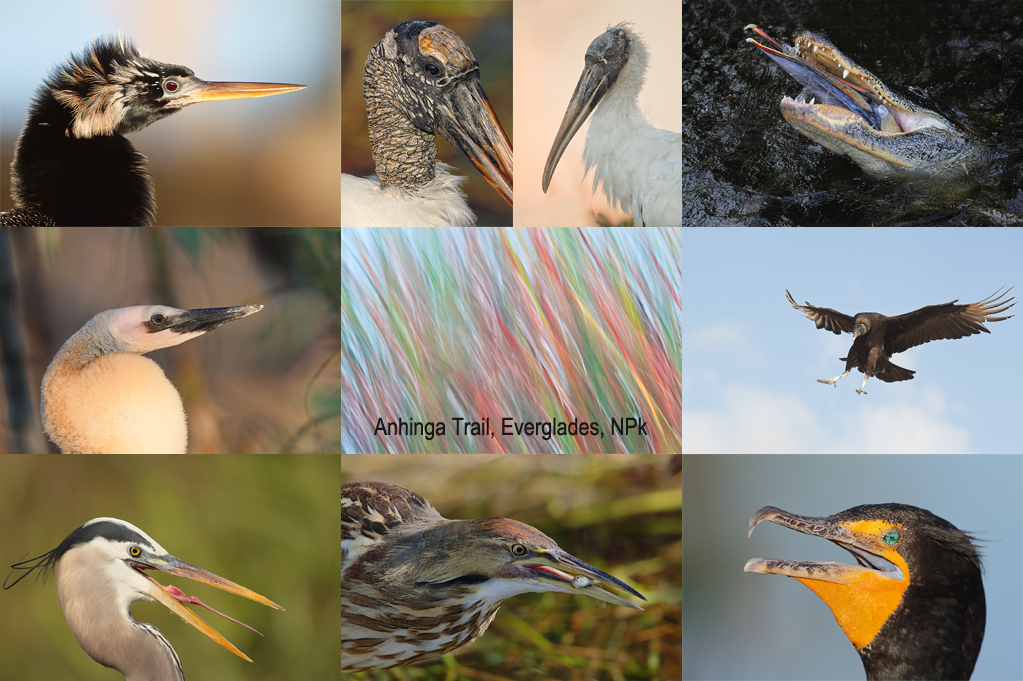
|
|
Bird Photography Hotspot: Anhinga Trail, Everglades National Park. Learn more here. |
Anhinga Trail/Everglades National Park Mini-IPT: Feb 1-2, (SAT/SUN), 2014. (Limit 12/Openings 5): $799. Introductory slide program: 7pm: FRI Jan 31. (Limit 14/Openings: 12):
Join Denise Ippolito and Arthur Morris for four great photography sessions at one of the top bird photography hotspots in North America. Morning sessions: 6:15am to 10:30am. Afternoon sessions: 3:00pm till 5:45pm. Lunch included. Informal image review and Photoshop sessions after lunch.
Jan 31 (Friday) Anhinga Trail/Everglades National Park Optional Add-on/Morning Only (Limit 14/Openings 12): $249
Includes lunch, and informal image review and Photoshop session.
2014 South Florida Composite IPT: 6 1/2 days of photography spread over 9 days of learning, hanging out, and travel: $2644. (Limit 12/Openings: 5
Because of our intense travel schedule that includes a trip to Japan I will not be running the traditional SW FLA IPT. In addition, in an effort to give some folks a chance to get a taste of our teaching and our passion for bird photography, Denise Ippolito and I have organized a series of short IPTs that may be combined into one wonderful experience or enjoyed piecemeal. Click here for complete details or to register. Please e-mail with any questions or leave a comment below.
A $500 non-refundable deposit is required to hold your slot for this IPT. For the short segments that are less than $500 payment in full is due at the time of registration. Your balance is due 4 months before the date of the IPT and is also non-refundable. If the trip fills, we will be glad to apply a credit applicable to a future IPT for the full amount less a $100 processing fee. If we do not receive your check for the balance on or before the due date we will try to fill your spot from the waiting list. If your spot is filled, you will lose your deposit. If not, you can secure your spot by paying your balance. Best to call Jim or Jennifer with a credit card in hand to register. Credit cards are not accepted for balances. Alternatively you can send a check for $500 made out to Arthur Morris to us at PO Box 7245, Indian Lake Estates, FL, 33855. Please include a note with your e-mail address and be sure to let us know what you are signing up for.
Support the BAA Blog. Support the BAA Bulletins: Shop B&H here!
We want and need to keep providing you with the latest free information, photography and Photoshop lessons, and all manner of related information. Show your appreciation by making your purchases immediately after clicking on any of our B&H or Amazon Affiliate links in this blog post. Remember, B&H ain’t just photography!




Amazon
Everyone buys something from Amazon, be it a big lens or deodorant. Support the blog by starting your search by clicking on the logo-link below. No purchase is too small to be appreciated; they all add up. Why make it a habit? Because I make it a habit of bringing you new images and information on an almost daily basis.
Typos
In all blog posts and Bulletins, feel free to e-mail or to leave a comment regarding any typos, wrong words, misspellings, omissions, or grammatical errors. Just be right. 🙂
IPT Info
Many of our great trips are filling up. See especially info on the South Florida, Holland, and Nickerson Beach IPTs. Two great leaders on most trips ensure that you will receive individual attention, have all of your questions answered, and learn a ton including how to think like a pro, see the situation, and get the right exposure every time. In addition you will have fun, and make lots of great images. Click here for IPT details and general information.

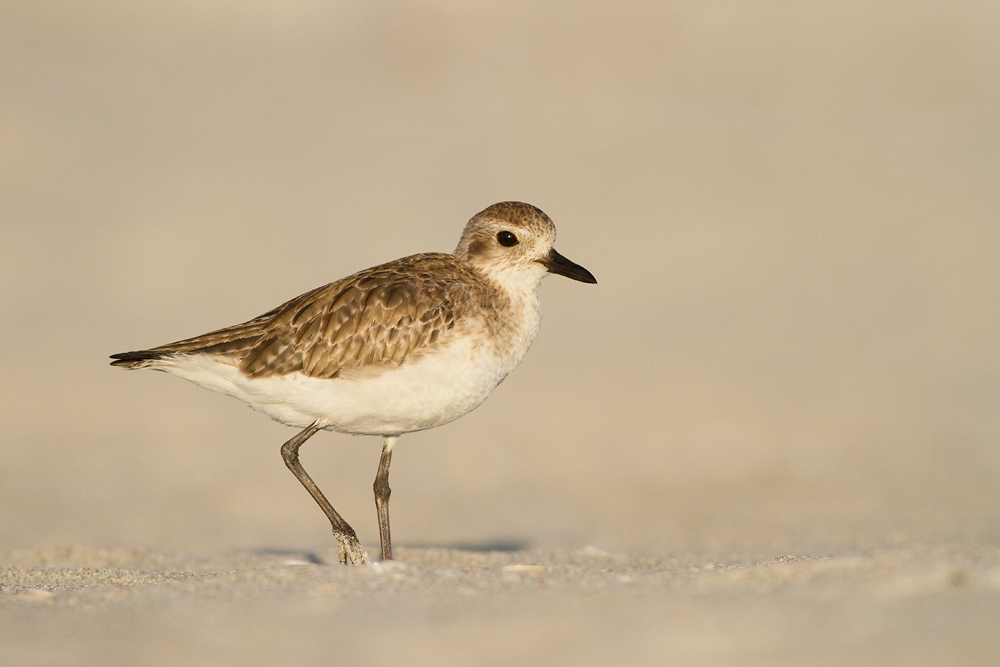















image 4 is SWEET!!!
Just wanted to say how much I enjoy your blogs and the comments this is some streak you have going Artie.
Thanks
Gordon
Being a self-taught photographer I read, read, and read some more. Your site is one that pops up to read early each morning before heading out an hour before sunrise. I am delighted this morning to read a post with affordable for me gear. I use 7D and recently upgraded from Sigma 150-500 to Canon EF 400 F5.6. Being stubborn I only shoot Jpeg with an every 6 month week of shooting raw (to see what I am missing)before returning to the simplicity of jpeg. All my images are processed with freeware (Photo Filtre Version 6.5). The reason is I attempt to post 12 quality images each day on my blog (quick processing time is of the essence). Thank You for the informational posts that feed my learning curve. As in anything one must do the work for me that means a visit here each day along with shooting, shooting, and shooting.
Nicely done with the 7D. I use the 7D and 300 f4 with 1.4 extender for roughly equivalent reach, and it does have IS. It works pretty well for Sand Hill Cranes and Eagles, but song birds in the wild remains a challenge to be mastered. I have used the 100-400 with the 7D, but the capture seems to have a little less detail.
Art: I own that exact combination (7D and 400 f/5.6) and it work well for me, in most cases. The lens is excellent and easy to hand hold. The problem is with the noisy images, once I get to iso 800. The noise is way too much for my taste. I try not to shoot above iso 400 with the 7D. Even my old 1D Mark IIn does better with higher iso’s. As you know that is 2 generations older than the 7D. I wish Canon would come out with an upgrade that does better at high iso’s. BTW I am pushing the histogram to the right. At iso 800 the highlights are fine but when there are shadows…ugh!
P.S. Interestingly none of the above images were taken at iso 800 or above.
Wonderful images from Dave. I like the 7D too. I continue to use it primarily with a 70-200 f/4L IS, but I have used it frequently with the 500 mm f/4L IS Mark I, often with a EF 1.4x TC II. The 7D is terrific with the 500, most of the photographs on the “Current Favorites” page of my website (denniszaebst.photography.com) were made with this combination, or the 7D+500+1.4x TC. I most frequently use the 500 on a gimbal mount, especially when I use the 1.4x as it’s a bit heavy to use handheld (for me). I even have a few that were taken at ISO 2000, in good light, which look great (with a little help from LR’s noise reduction and adjustment brush), such as the tight portraits of displaying GBHs at Venice rookery.
Great article, Dave and Artie
I to have a 7D and it’s nice to see those great images ! Dave your right on about the light and the 7D, it sure does way better the more light you have!
Does anyone have any info on how the 7D does with the 500 is version one lens? Or the 300 2.8 ver one. Please do tell.
Thanks for the inspiration Dave and it’s always a pleasure reading these blogs and reading Arites books, I have learned so much these last two years.
Craig
Artie and Dave, This was a great lesson in attitude and execution. David’s work is beautiful, especially that last silouette scene and I feel very inspired after viewing. Thanks!
Hi, Artie and Dave. Thanks for this wonderful blog post. My Canon 7D and Canon 400 f/5.6L are my treasures, although I should learn to be gentler with the lens. I agree with all of it based on my experience. When I photograph hummingbirds in sunlight, for example, I usually use ISO 800 and sometimes even 1600 if the sunlight is hazy, to get high shutter speeds; and noise is not a major problem. But in low light, it is at those ISOs. So Artie, the snowy owl photo I sent you, taken in downtown Washington DC at night, is one I couldn’t have made with the 7D/400 f/5.6L combo. Instead I handheld a Canon 6D and the amazing 70-200 f/2.8L IS II at ISO 3200, f/2.8, and 1/30. The IS is so good that the image was reasonably sharp. As for Dave’s wish for an IS version of the 400, well, the 70-200 f/2.8L IS II with a 2X Canon TC III seems to be a reasonable substitute, judging from Artie’s and others’ spectacular images! Thanks again, and for the link. I love this blog and Dave’s wonderful images, and of course Artie’s and the wonderful blogs, books, and so on, inspire me to go out and do better!